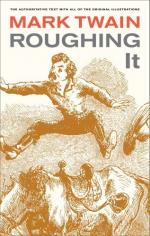and for the quarter ending on the 30th of last June,
about $1,600,000. Thus in a year and a half,
the Virginia office only shipped $5,330,000 in bullion.
During the year 1862 they shipped $2,615,000, so
we perceive the average shipments have more than doubled
in the last six months. This gives us room to
promise for the Virginia office $500,000 a month for
the year 1863 (though perhaps, judging by the steady
increase in the business, we are under estimating,
somewhat). This gives us $6,000,000 for the year.
Gold Hill and Silver City together can beat us—we
will give them $10,000,000. To Dayton, Empire
City, Ophir and Carson City, we will allow an aggregate
of $8,000,000, which is not over the mark, perhaps,
and may possibly be a little under it. To Esmeralda
we give $4,000,000. To Reese River and Humboldt
$2,000,000, which is liberal now, but may not be before
the year is out. So we prognosticate that the
yield of bullion this year will be about $30,000,000.
Placing the number of mills in the Territory at one
hundred, this gives to each the labor of producing
$300,000 in bullion during the twelve months.
Allowing them to run three hundred days in the year
(which none of them more than do), this makes their
work average $1,000 a day. Say the mills average
twenty tons of rock a day and this rock worth $50
as a general thing, and you have the actual work of
our one hundred mills figured down “to a spot”—$1,000
a day each, and $30,000,000 a year in the aggregate.—Enterprise.
[A considerable over estimate—M. T.]]
Two tons of silver bullion would be in the neighborhood
of forty bars, and the freight on it over $1,000.
Each coach always carried a deal of ordinary express
matter beside, and also from fifteen to twenty passengers
at from $25 to $30 a head. With six stages going
all the time, Wells, Fargo and Co.’s Virginia
City business was important and lucrative.
All along under the centre of Virginia and Gold Hill,
for a couple of miles, ran the great Comstock silver
lode—a vein of ore from fifty to eighty
feet thick between its solid walls of rock—a
vein as wide as some of New York’s streets.
I will remind the reader that in Pennsylvania a coal
vein only eight feet wide is considered ample.
Virginia was a busy city of streets and houses above
ground. Under it was another busy city, down
in the bowels of the earth, where a great population
of men thronged in and out among an intricate maze
of tunnels and drifts, flitting hither and thither
under a winking sparkle of lights, and over their
heads towered a vast web of interlocking timbers that
held the walls of the gutted Comstock apart.
These timbers were as large as a man’s body,
and the framework stretched upward so far that no
eye could pierce to its top through the closing gloom.
It was like peering up through the clean-picked ribs
and bones of some colossal skeleton. Imagine
such a framework two miles long, sixty feet wide, and




